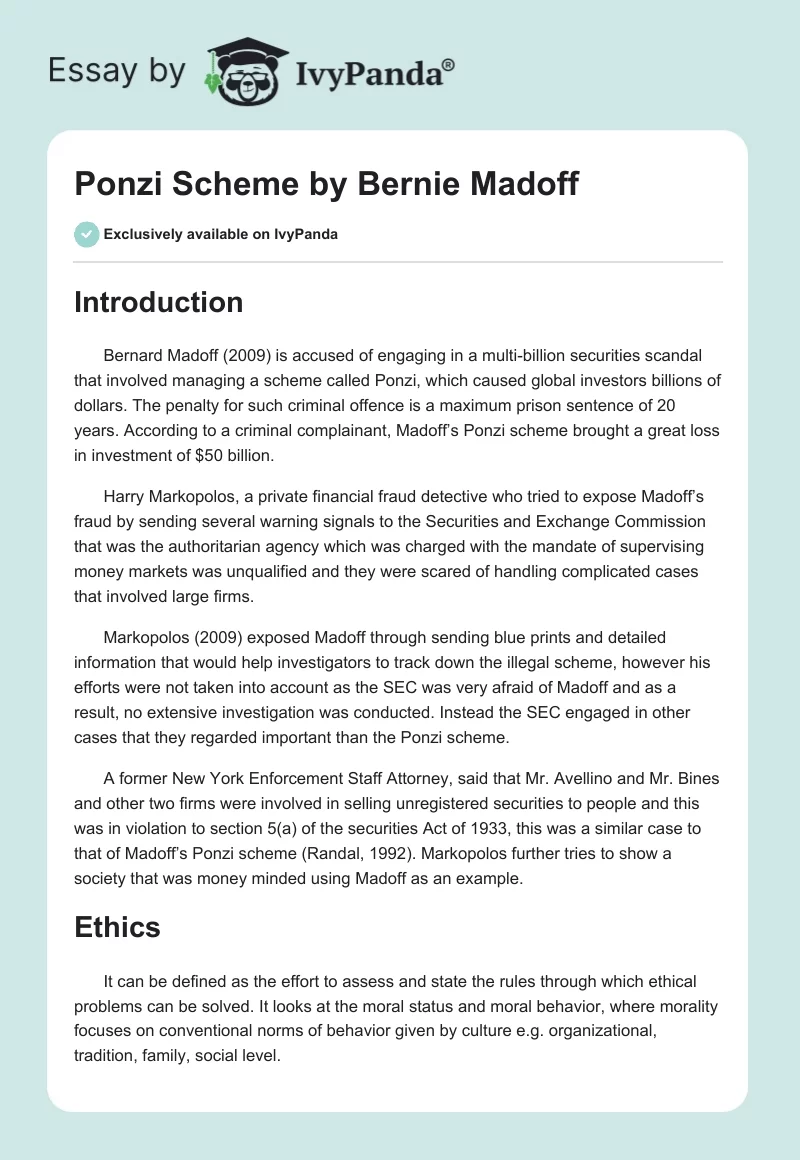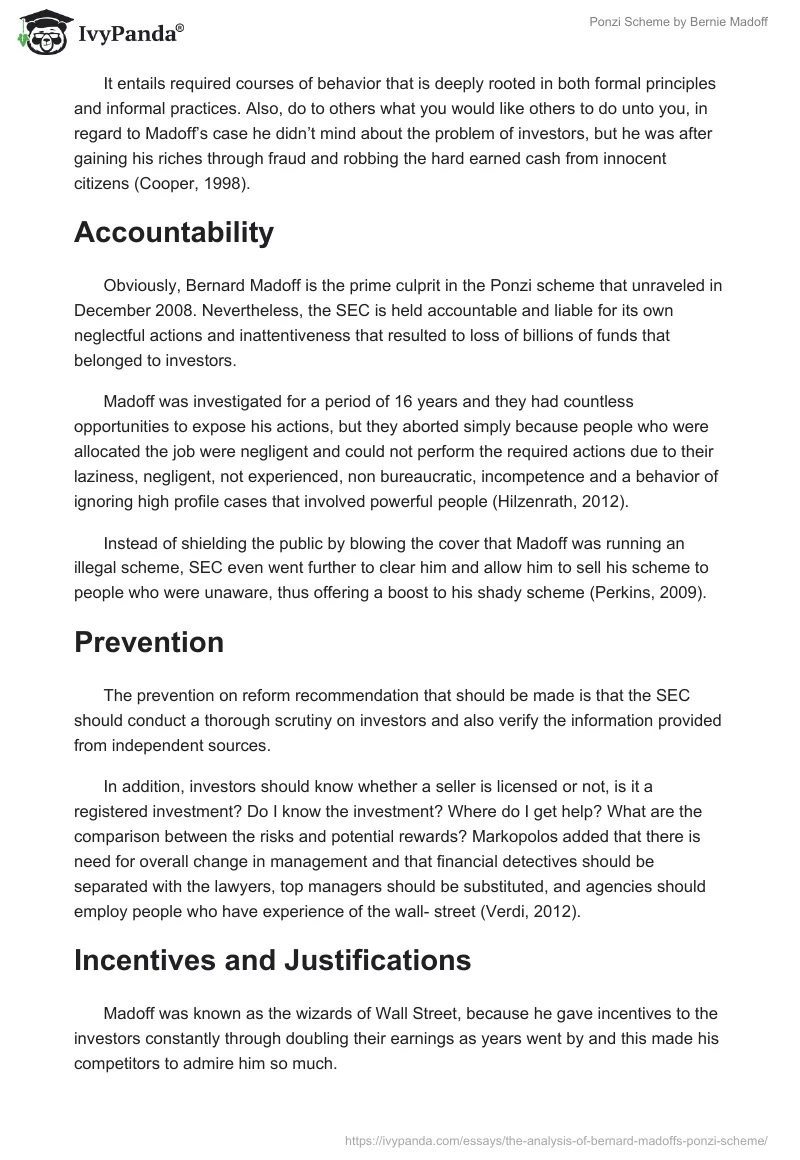Introduction
Bernard Madoff (2009) is accused of engaging in a multi-billion securities scandal that involved managing a scheme called Ponzi, which caused global investors billions of dollars. The penalty for such criminal offence is a maximum prison sentence of 20 years. According to a criminal complainant, Madoff’s Ponzi scheme brought a great loss in investment of $50 billion.
Harry Markopolos, a private financial fraud detective who tried to expose Madoff’s fraud by sending several warning signals to the Securities and Exchange Commission that was the authoritarian agency which was charged with the mandate of supervising money markets was unqualified and they were scared of handling complicated cases that involved large firms.
Markopolos (2009) exposed Madoff through sending blue prints and detailed information that would help investigators to track down the illegal scheme, however his efforts were not taken into account as the SEC was very afraid of Madoff and as a result, no extensive investigation was conducted. Instead the SEC engaged in other cases that they regarded important than the Ponzi scheme.
A former New York Enforcement Staff Attorney, said that Mr. Avellino and Mr. Bines and other two firms were involved in selling unregistered securities to people and this was in violation to section 5(a) of the securities Act of 1933, this was a similar case to that of Madoff’s Ponzi scheme (Randal, 1992). Markopolos further tries to show a society that was money minded using Madoff as an example.
Ethics
It can be defined as the effort to assess and state the rules through which ethical problems can be solved. It looks at the moral status and moral behavior, where morality focuses on conventional norms of behavior given by culture e.g. organizational, tradition, family, social level.
It entails required courses of behavior that is deeply rooted in both formal principles and informal practices. Also, do to others what you would like others to do unto you, in regard to Madoff’s case he didn’t mind about the problem of investors, but he was after gaining his riches through fraud and robbing the hard earned cash from innocent citizens (Cooper, 1998).
Accountability
Obviously, Bernard Madoff is the prime culprit in the Ponzi scheme that unraveled in December 2008. Nevertheless, the SEC is held accountable and liable for its own neglectful actions and inattentiveness that resulted to loss of billions of funds that belonged to investors.
Madoff was investigated for a period of 16 years and they had countless opportunities to expose his actions, but they aborted simply because people who were allocated the job were negligent and could not perform the required actions due to their laziness, negligent, not experienced, non bureaucratic, incompetence and a behavior of ignoring high profile cases that involved powerful people (Hilzenrath, 2012).
Instead of shielding the public by blowing the cover that Madoff was running an illegal scheme, SEC even went further to clear him and allow him to sell his scheme to people who were unaware, thus offering a boost to his shady scheme (Perkins, 2009).
Prevention
The prevention on reform recommendation that should be made is that the SEC should conduct a thorough scrutiny on investors and also verify the information provided from independent sources.
In addition, investors should know whether a seller is licensed or not, is it a registered investment? Do I know the investment? Where do I get help? What are the comparison between the risks and potential rewards? Markopolos added that there is need for overall change in management and that financial detectives should be separated with the lawyers, top managers should be substituted, and agencies should employ people who have experience of the wall- street (Verdi, 2012).
Incentives and Justifications
Madoff was known as the wizards of Wall Street, because he gave incentives to the investors constantly through doubling their earnings as years went by and this made his competitors to admire him so much.
The investors were not aware of his intentions with this constant rewards and promises made by Madoff, unlike the SEC who were well informed with his actions until when the cover was clearly blown. The SEC members who examined Madoff were not abiding by the rules, but they just carried their usual procedures and nothing was done completely (Chernoff, 2009).
References
Cooper, T. (1998). The Responsible Administrator: An Approach to Ethics for the Administrative Role (4th ed.). San Francisco: Jossey-Bass.
Chernoff, A. (2009). Sr. Correspondent, Madoff’’s whistleblower blasts SEC. Web.
Hilzenrath, D. (2012). Madoff continues to haunt SEC in Hill hearing on budget request. Web.
Madoff, B. (2009). Former Chairman, Investment Securities LLP. Chicago: Routledge.
Markopolos, H. (2009). Assessing the Madoff Ponzi Scheme and Regulatory Failures: Hearing Before the H. Comm. on Financial Services. NY: Spring publishers.
Perkins, E. (2009). Former Examiner (now Staff Accountant). New York: Regional Office, Securities and Exchange Commission.
Randal, S. (1992). Wall Street Mystery Features a Big Board Rival. The Wall Street Journal, Vol (6): 77-82.
Verdi, N. (2012). Allen Stanford Convicted In $7 Billion Ponzi Scheme. Web.


